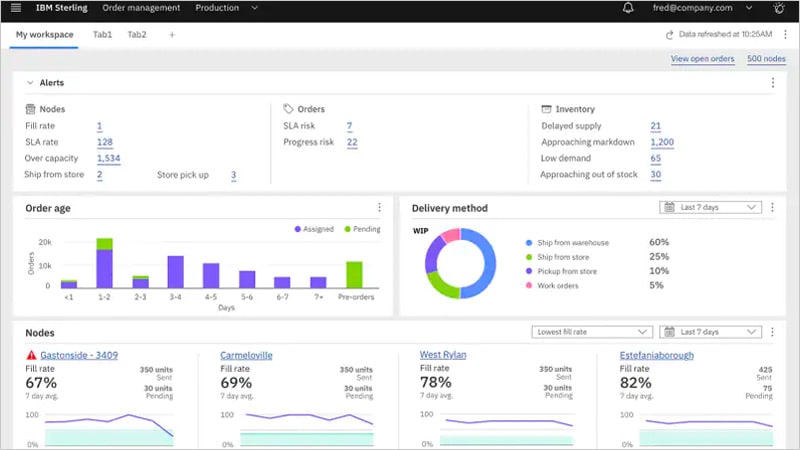What Is Sterling Order Management and OMS Alternatives?

IBM Sterling Order Management is a robust order management system (OMS) that lets organizations track orders, manage processes and data, and visualize every order in real-time across channels from a streamlined dashboard.
Back in 2010, IBM acquired Sterling Commerce from AT&T for $1.4 billion. Since the acquisition, companies of varying sizes—like JFE Steel Corporation, John Lewis and Partners, and Pitney Bowes—have used the Sterling Order Management system to track all information about an order as it moves through the fulfillment process.
But, consumer behavior is quickly changing, and today’s customers seek more flexibility and personalization when shopping with retailers and brands. Amazon contributed greatly to today’s customer demands by providing a one-day delivery service to its prime members. This strategy increased Amazon’s net revenue to $386.06 billion in 2020, from $280.52 in the previous year.
It’s important to know that Amazon doesn’t provide its delivery services using monolithic services like IBM OMS. Instead, their obsession with personalized customer experience and providing fast and reliable deliveries forced them to embrace headless commerce, implementing a microservices-based architecture where the backend components function as independent services. That said, IBM Sterling is not without its uniqueness and benefits.
In this post, we’ll look at what the Sterling Order Management system is today, likely alternatives, and why you should choose headless e-commerce instead.
[toc-embed headline=”Sterling OMS Overview”]
Sterling OMS Overview
IBM Sterling OMS became a market leader in the order fulfillment industry because of the depth, breadth, and sophistication of the solution’s functionality. Complete omnichannel inventory visibility, order orchestration, BOPIS (buy online pickup in-store), order routine for fulfillment, and returns processing all make this tool worth considering. It also nails some other use cases, including ship-from-store (SFS), save-the-sale, buy online ship-to-store (BOSS), and buy online/return in-store (BORIS).

IBM Sterling ensures solid performance with its optimized fulfillment performance in stores, call centers, logistics, and distribution with unified omnichannel fulfillment and returns. It also provides enterprise integrations to help implement the solution that enables access to backend systems such as Oracle, SAP, websites, accounting applications, invoicing servers, fulfillment warehouses, payment processing systems, and customer support.
Pros of Sterling OMS
- Provides flexibility that allows it to integrate with multiple external systems
- Easy to understand once you learn the basics
- Provides features that make enhancements or integrations with other applications easier
- Logistics work at the SKU/quantity level
- Intelligent sourcing and scheduling
- Coordinated, customized fulfillment execution to support various selling channels and both internal and external supplies
Cons on Sterling OMS
- It takes longer to deploy, even for very small changes
- The user interface is click intensive: a user must either mouse-click or keyboard-stroke an inordinate amount to accomplish a routine task
- Expensive to maintain; only worth considering for companies with higher budgets
- Has been unable to generate significant sales momentum with their warehouse management system
- It’s complex to learn the system in the beginning, and there are not many documents available online to act as a guide
[toc-embed headline=”Traditional Alternatives to IBM Sterling Order Management System”]
Traditional Alternatives to IBM Sterling Order Management System
If you’re looking to try out other traditional order management systems, there are hundreds from which to choose. However, below are popular ones in the market, along with their benefits and potential downsides to help you decide on which one is best for your business:
- Manhattan Order Management: Manhattan’s central repository provides a 360 view of the customer’s online and in-store order. Offering plenty of implementation help, it provides reliable third-party vendors to help you set up your OMS and ensures a streamlined order fulfillment process. But, while using this tool, it’s common to find some major administrative tools not functioning as needed. The UI is also not friendly, and it’s hard to alternate the experience from brand to brand.
- Salesforce Order Management: Salesforce OMS empowers merchants to deliver flexible, omnichannel journeys at scale. It’s fast and analyzes consumer behavior in real-time. In addition, the tool eliminates the need for customer interaction for common tasks. The major downsides are the complexity of its programming language and dependence on implementation partners for upgrades and fixes.
- Oracle Order Management Cloud: Oracle OMS powers the order fulfillment of brands like Alcar, Orange, and The Wonderful Company. The tool makes it easier to create reports and offers comprehensive order management processes. However, it’s a common error to find orders open, even after they’ve been shipped. Plus, its user interface is not user-friendly and takes longer to master.
[toc-embed headline=”Modern Alternatives to IBM OMS”]
Modern Alternatives to IBM OMS
Although effective to some extent, traditional order management systems are rigid and do not offer the flexibility and adaptability needed to keep pace with today’s consumer demands. Deployment may take weeks or months to happen; monolithic systems are expensive to maintain; changes are too complex, and most dashboards are not user-friendly.
In today’s connected digital world, consumer behavior is evolving faster, and 59% of consumers have higher expectations for customer service than they did a year ago. To keep up with this ongoing demand, brands and retailers must adopt the headless approach.
Headless commerce gives you the control to make quick changes and provide a consistent customer experience across channels. A headless order management system (OMS) fits in with both existing tech and the users. The last thing you ever want is to see your site crash on Black Friday. Headless OMS prevents that from happening by providing you with a backend technology that is easily customizable and handles big changes.
Examples of headless order management systems are:
Improve your order management with fabric OMS
fabric OMS improves the order management process by bringing orders, inventory, and warehousing into a single system. With OMS APIs, you can connect your existing e-commerce systems or third-party services, achieving fast and affordable order fulfillment across the channel.

Furthermore, fabric order management software allows you to integrate seamlessly with other e-commerce infrastructure, helping users collaborate more efficiently.
[toc-embed headline=”Key Takeaways”]
Key Takeaways
- IBM Sterling Order Management system is a market leader in the traditional monolithic space because of the sophistication of the solution’s functionality.
- Because of the complexity, high cost, lack of flexibility, and longer deployment times of monolithic software options like Sterling Order Management, they are not great options to help brands meet today’s ever-growing customer demands.
- Headless OMS eliminates the issues associated with traditional order management solutions by providing merchants with a backend that is flexible, easy-to-deploy, and affordable, letting you make quick changes and provide exceptional customer experience across channels.
- fabric OMS provides a centralized hub where you can control order fulfillment, warehouse management, and inventory management in a single system while also letting you connect with third-party logistics companies quickly and easily.

Tech advocate and writer @ fabric.